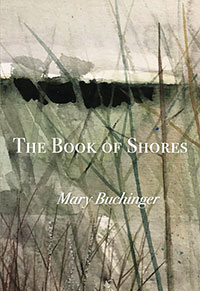 *
*
Reviewed by Off the Shelf Correspondent Thomas DeFreitas
The late American poet Donald Justice once offered his opinion that American poets fall into one of two “camps”: the Walt Whitman camp and the Emily Dickinson camp. Whitman-poets are marked by their rambunctious, capacious inclusivity, their embracing acceptance of everything from stamen to stevedore, from wisteria to winebibber. Dickinson-poets are marked by cadence and deliberation, by a discriminating selectivity, by the understated emphasis on one or two painstakingly chosen things. (Justice himself professed a preference for Dickinson’s “closed room”).
In The Book of Shores, and elsewhere, it is Mary Buchinger’s good fortune to have united these two opposite tendencies in one glorious aesthetic: yes, there is thoughtful, measured pacing; there are words carefully chosen, a luminous attention to the “minute particulars” (as Blake called them); but there is also expansion and invitation, there is acceptance of all material as poetically valid and vivid, there is the conscious capacity to admit and welcome the domestic vignette, the surreal and dream-like moment, and the globally pertinent “statement.”

The Book of Shores
by Mary Buchinger
Lily Poetry Review Press
2024, 102 pp.
The form of The Book of Shores will be familiar to those who have read Buchinger’s Virology, her long poem alert to pandemic realities. Shores falls into seven “chapters”: Seaway, Island, Peninsula, Archipelago, Strait, [INLAND], and Continent. Each section is a chain of much smaller poems, exquisite and intricate lyrics, connected and separated by an asterisk or some other form of punctuation, as we find in Robert Creeley’s seminal book Pieces.
Careful observation marks each turn and twist of the word-flow, where “cumulus snags / the upper branches / of an invisible tree”; where “the smallest pieces of meaning” are not neglected; where Buchinger’s eye takes in “nets and knots of cloud / figment and fragment.” There is alertness to the animal world, be it a tawny spider in the sleeve of a bathrobe, a surprise for the narrator at her morning tea, or the cat whose “compact coil” in the speaker’s lap “thrums with warmth.”
In Peninsula Buchinger alludes to the semicolon as a symbol of mental-health awareness. “It demonstrates,” she tells us in her Notes, “continuation with a new beginning as opposed to the finality of a period.” Or as the poem phrases it, “it signifies a decision / to not end.” One sees kinship with Buchinger’s method: after each asterisk or semicolon, a fresh start, a new “independent clause” of poetry, shining and graspable, luminous and within reach.
“Sometimes,” the narrator concedes, “I feel ready to excise and renew” (in sympathy with a friend who had “cancelled” her own past), but memory is tenacious, perhaps especially in Archipelago, where the imagery ranges from a child of some decades ago watching Sears catalogs incinerate in a barrel, to a poet of this moment as she is nagged by the small dings of her mobile phone. We feel as if we are reading “remnants of a great lecture” where the parts are of vital importance, as in dreams, but the larger themes are left implicit (as in dreams!). We have hymnody educed from drooping flower-petals; we have the archipelago as “crowd-funded geography.” In a sentence that Whitman could have written, “I wake to the history / of my body, each day / another jotting.”
In Strait, the narrator admits that the “mother tongue” she speaks can sound “foreign”; she speaks further of “translation / from one language to another / feeling into word.” But Buchinger’s alertness and unswerving purpose makes these translations as palpable and handy as the weight of a necklace “lodged / in the linty corner / of my winter jacket.” Walking through this section, we have the poet in sandals that are pretty but which draw blood; the poet’s aging mother walking “like a penguin”; and a concert attendee leaving a performance of Buxtehude in a rush: “the stranger’s sudden departure / changes what I hear.”
The section called INLAND finds Buchinger as anthologist of startlements and surprises, even of shocks. We have “stakes of herons / stately in ebbtide”; “an ankle-deep sea / of economy”; “a shiny miry / mirror / of sun.” We have the beauty of the Self “who carried the sea wherever she went”; INLAND as “a skiffless interior” with “a stillborn moon … incubator / of storm & misdirection.” Rhymes are discovered: “aghast” with “a guest”; “nest algae” with “nostalgia.” The narrator dusts a moose’s skull, its “white machinery / of ovals and holes”; “to look into this moose’s eyes / I’d have to enter the earth.” The poet gives us nature red in tooth and claw, as an Eagle (she capitalizes its name, as one might the Grim Reaper’s!) swoops and assaults a fawn.
In the coda called Continent, Buchinger ponders “the green … fields” of her manuscript, “its hungry regions and mossy passages” and expresses the belief that “possibility dwells within its rifts.” There is much in The Book of Shores that this reviewer finds to be challenging, moments and occasions that linger on the outskirts of comprehension. But there is far more that invites, that spurs us to plunge in. There are surprises waiting in the reeds and the bulrushes. Buchinger urges us always to seek, as we will surely find.

 https://www.portersquarebooks.com/
https://www.portersquarebooks.com/













Reader Comments